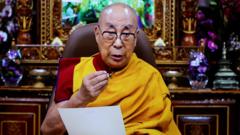In a significant announcement marking his 90th birthday celebrations, the Dalai Lama confirmed the existence of a successor to carry on the revered institution of the Dalai Lama after his passing. This declaration, communicated via a video message, effectively ended longstanding doubts regarding the future of the lineage that has endured for six centuries. The Dalai Lama emphasized that only the Gaden Phodrang Trust, which he established, holds the authority to appoint his successor, asserting that external interference will not be tolerated.
Amid swirling tensions regarding Tibet's political status and religious freedoms, the Dalai Lama's assertion that his successor must be recognized outside of China posed a direct challenge to Beijing's authority. China's government responded swiftly, asserting that any future Dalai Lama must be vetted according to its laws and government protocols, a stance historically challenged by the Tibetan community.
On the day of the announcement, hundreds of devoted followers gathered in Dharamshala, India, drawn by the magnetic presence of the Dalai Lama. The atmosphere was charged with emotion, giving way to expressions of relief and joy. Supporters echoed sentiments of hope for the future of the Dalai Lama's legacy, with Tsayang Gyatso, a Tibetan businessman, openly sharing his elation at the reaffirmation of the lineage's continuation.
Academics and scholars note that this announcement not only strengthens the spiritual and cultural fabric of Tibetan Buddhism but also serves as an indirect message to China, underscoring a community-driven legitimacy rather than one imposed by force. However, experts caution that Beijing may attempt to create its own version of a successor, a move likely to be met with widespread rejection within the Tibetan diaspora and the global community.
As celebrations for the Dalai Lama's milestone birthday draw thousands from around the world, the implications of his statement on successor recognition remain a critical point of dialogue, shedding light on the deeper struggles for identity, autonomy, and rights within the Tibetan context.
Amid swirling tensions regarding Tibet's political status and religious freedoms, the Dalai Lama's assertion that his successor must be recognized outside of China posed a direct challenge to Beijing's authority. China's government responded swiftly, asserting that any future Dalai Lama must be vetted according to its laws and government protocols, a stance historically challenged by the Tibetan community.
On the day of the announcement, hundreds of devoted followers gathered in Dharamshala, India, drawn by the magnetic presence of the Dalai Lama. The atmosphere was charged with emotion, giving way to expressions of relief and joy. Supporters echoed sentiments of hope for the future of the Dalai Lama's legacy, with Tsayang Gyatso, a Tibetan businessman, openly sharing his elation at the reaffirmation of the lineage's continuation.
Academics and scholars note that this announcement not only strengthens the spiritual and cultural fabric of Tibetan Buddhism but also serves as an indirect message to China, underscoring a community-driven legitimacy rather than one imposed by force. However, experts caution that Beijing may attempt to create its own version of a successor, a move likely to be met with widespread rejection within the Tibetan diaspora and the global community.
As celebrations for the Dalai Lama's milestone birthday draw thousands from around the world, the implications of his statement on successor recognition remain a critical point of dialogue, shedding light on the deeper struggles for identity, autonomy, and rights within the Tibetan context.



















